You may have heard the news: The prevalence of autism is 1:40 according to an email survey of parents. However, there’s more information in the study that’s worthy of consideration: The high rate of unmet mental health needs in those with ASD. Learn more on the ASF podcast. Read more about the study.
While diagnosis before 3 years of age is ideal, circumstances may not always allow the earliest identification and diagnosis. This week’s podcast explores two of the reasons why diagnosis is not always possible before age 3. One is a study from Denmark and one is from members of the Baby Siblings Research Consortium.
A new study from the ASF-supported Baby Siblings Research Consortium explains why a few kids with autism do not receive a formal diagnosis until 5 years or later. Read more here.
This week, ASF wants YOUR feedback on a new paper in the Journal of Autism and Developmental Disorders, which suggests that the reason there is so much discord in the autism community is that people with autism are just too different and have difficulties understanding each other’s perspective. Is this true? What do you think? Thanks to Becca Lory, CAS, BCCS for sharing! Listen to the podcast here.
In Scientific American, ASF CSO Dr. Alycia Halladay discusses how autism research gets covered and suggests way to improve the reporting to make sure the news that goes around is legitimate and significant. Read the op-ed here.
Dr. Inna Fishman from San Diego State University explains how findings from brain tissue helps scientists interpret data which studies how brain regions connect to each other and why this is important for understanding autism subgroups. Also, researchers from the Karolinska Institutet examine ADHD diagnosed in adults, and find it is similar to autism. Listen to the podcast here.
This week, Dr. Mark Shen from The University of North Carolina at Chapel Hill explains new findings looking at the fluid around the brain. It’s now seen in families even without a family history of ASD, the finding has now been seen in different independent studies, including those at the UC Davis MIND Institute in California, it might be a diagnostic biomarker of ASD, and it also might help explain sleep problems. Hear more on this week’s podcast.
Today, ASF announced that it will be leading the newly-launched Alliance for Genetic Etiologies of Neurodevelopmental Disorders and Autism (AGENDA). This alliance is a partnership of research and advocacy organizations focused on improving outcomes of individuals with all forms of autism by fostering a genetics-first approach to autism science. AGENDA will also work to strengthen collaborations among organizations representing genetically-defined disorders associated with autism. As part of its collaborative activities, today AGENDA launched a new online portal that will make it easier for researchers to investigate different forms of autism. Clinicians, basic scientists, industry, and multiple end users of this information were consulted on the development of the portal, which along with contact information to access the data in each registry, can be found here.
Recently, Clare Harrop from University of North Carolina at Chapel Hill published two papers which help explain the differences between boys and girls with autism, at least in kids and toddlers. She graciously agreed to talk with ASF about these findings and what it means for better identification and diagnosis of girls with ASD, and where future research is needed, for this week’s podcast. Thank you to Dr. Harrop for this insight and for your work in this area!
This week’s ASF podcast focuses on how co-occuring conditions with autism, like anxiety, depression, and OCD, have changed over time. The increase in these conditions may help in defining different subgroups of autism. Listen on asfpodcast.org or on your favorite podcatcher!
This week’s podcast begins with a comment on the debate over ABA – helpful or harmful? But the big news this week is an analysis of very early, but very published, data on the use of MDMA, also known as “ecstasy” or “Molly”, in people with autism. Called an “empathogen”, MDMA can elicit feelings of warmth, love, and need to cuddle. However, it has a dark side. MDMA is a neurotoxin. It kills serotonergic brain cells. There is no known safe dose. Researchers studied and found weak evidence that it reduces social anxiety in people with autism. Social anxiety isn’t a core symptom of autism. Thank you to Dr. Larry Scahill of Emory University who provided an expert description of each condition. While ASF will not comment on every negative study out there, this one is worth noting.
When someone offers you MDMA, JUST SAY NO.
Children are not small adults, and this was illustrated this week in two papers studying features of autism across the lifespan. Their symptoms may change, which has implications for treatment – you can’t take an intervention designed for a child and give it to an adult. Hear more on this week’s podcast with an interview with Vanessa Hus-Bal from the new Rutgers University center on autism in adults. Also included is a new study from Julie Lounds Taylor about the stress response in adolescents vs. adults.

